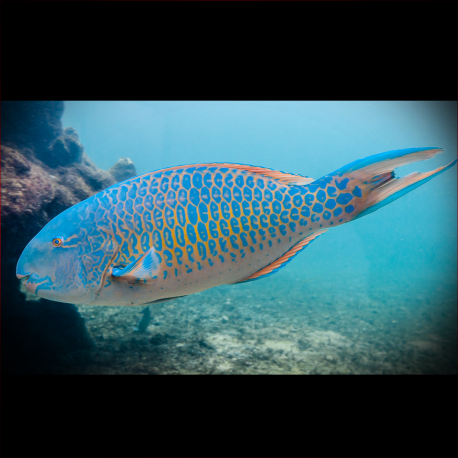More info
Datasheet
| Minimum Tank Size | 3000 litres / 792.52 US gallons |
| Maximum Size | 75.0cm / 29.53inches |
| Reef Compatible | Unknown |
| Temperament | Peaceful |
| Temperature | 22.2°C / 71.96°F - 25.6°C / 78.08°F |
| Specific Gravity | 1.020-1.025 |
| Carbonate Hardness | 8-12 |
| pH | 8.1-8.4 |
General Description
The Blue-barred parrotfish, scientifically known as Scarus ghobban, is a vibrant and colorful species belonging to the Scaridae family. These fish are known for their distinctive blue bars and can grow up to a maximum size of 75.0cm. Found in the East Indian Ocean, West Indian Ocean, Australia, Japan, The Red Sea, Indonesia, and the Pacific regions, they exhibit a peaceful temperament and are considered hardy in terms of their overall health and survival.
Aquarium Suitability
Although the Blue-barred parrotfish is deemed suitable for aquariums, it should be noted that they demand a very large tank, with a minimum size requirement of 3000 liters when fully grown. Due to their size and swimming habits, they require ample space for swimming and should be housed in environments that can handle their heavy feeding load.
Care and Hardiness
These fish have a fun and interesting personality and are effective algae-eaters, consuming large amounts of algae to maintain their health. They primarily feed on algae-based foods such as seaweed and spirulina, highlighting their need for a diverse diet. Blue-barred parrotfish are hermaphroditic, with the ability to change gender as needed.
Reef Suitability
The reef compatibility of the Blue-barred parrotfish remains unknown, thus caution should be exercised when introducing them to reef aquariums. They are known to graze on algae-covered rocks, which may impact the delicate balance of a reef ecosystem.
Aquarium Setup
When setting up an aquarium for Blue-barred parrotfish, it is essential to provide a spacious environment with ample hiding spots and rock formations. Maintaining a stable water temperature between 22.2-25.6°C, a pH level of 8.1-8.4, and a salinity range of 1.020-1.025 is crucial for their well-being.
Behaviour
Blue-barred parrotfish revel in swimming activities and display a peaceful temperament within a suitable aquarium environment. They are known to sleep in mucus cocoons formed between rocks, showcasing their unique behavior patterns.
Feeding and Diet
These fish primarily rely on macroalgae such as seaweed and microalgae like spirulina for their dietary needs. While they have a diverse appetite, algae-based foods should remain a staple in their daily feeding regimen to ensure optimal health.
Habitat and Distribution
The Blue-barred parrotfish can be found in the Indo-Pacific region, ranging from the Red Sea and Algoa Bay, South Africa, to various islands in the Pacific. Their distribution extends from southern Japan to regions like Perth, New South Wales, and the Gulf of California to Ecuador in the Eastern Pacific. This species thrives in coral reef environments where they can graze on algae-covered surfaces for sustenance.

